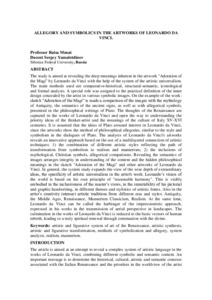Показать сокращенную информацию
ALLEGORY AND SYMBOLICS IN THE ARTWORKS OF LEONARDO DA VINCI.
| Автор | Ямалетдинов, Сергей Федорович | |
| Автор | Мусат, Раиса Павловна | |
| Дата внесения | 2020-01-20T07:53:35Z | |
| Дата, когда ресурс стал доступен | 2020-01-20T07:53:35Z | |
| Дата публикации | 2018-10 | |
| Библиографическое описание | Ямалетдинов, Сергей Федорович. ALLEGORY AND SYMBOLICS IN THE ARTWORKS OF LEONARDO DA VINCI. [Текст] / Сергей Федорович Ямалетдинов, Раиса Павловна Мусат // 5th international multidisciplinary scientific conference on social Sciences and arts SGEM 2018: Series SGEM. — 2018. — Т. 5 (№ 6.3). — С. 3-10 | |
| URI (для ссылок/цитирований) | https://www.sgemsocial.org/index.php/conference-topics/jresearch?view=publication&task=show&id=1922 | |
| URI (для ссылок/цитирований) | https://elib.sfu-kras.ru/handle/2311/128973 | |
| Аннотация | The study is aimed at revealing the deep meanings inherent in the artwork "Adoration of the Magi" by Leonardo da Vinci with the help of the system of the artistic universalism. The main methods used are comparative-historical, structural-semantic, iconological and formal analysis. A special role was assigned to the practical definition of the inner design concealed by the artist in various symbolic images. On the example of the work-sketch "Adoration of the Magi” is made a comparison of the images with the mythology of Antiquity, the semantics of the ancient signs, as well as with allegorical symbols, presented in the philosophical writings of Plato. The thoughts of the Renaissance are captured in the works of Leonardo da Vinci and open the way to understanding the priority ideas of the thinker-artist and the meanings of the culture of Italy XV-XVI centuries. It is assumed that the ideas of Plato aroused interest in Leonardo da Vinci, since the artworks show the method of philosophical allegories, similar to the style and symbolism in the dialogues of Plato. The analysis of Leonardo da Vinci's artworks reveals an innovative approach based on the use of a multilayered connection of artistic techniques: 1) the combination of different artistic styles reflecting the path of transformation from symbolism to realism and mannerism; 2) the inclusions of mythological, Christian symbols, allegorical comparisons. Revealing the semantics of images arranges integrity in understanding of the content and the hidden philosophical meanings in the sketch "Adoration of the Magi" and other artworks of Leonardo da Vinci. In general, the system study expands the view of the wise depth of extraordinary ideas, the specificity of artistic universalism in the artist's work. Leonardo’s vision of the world is based on his own principle of "reasonable harmony". This is visibly embodied in the inclusiveness of the master’s views, in the inimitability of his pictorial and graphic handwriting, in different themes and stylistics of artistic forms. Also in the artist’s creativity intersect artistic traditions from different eras and styles: Antiquity, the Middle Ages, Renaissance, Mannerism Classicism, Realism. At the same time, Leonardo da Vinci can be called the harbinger of the impressionistic approach, expressed in his works in the transmission of aerial perspective in landscapes. The culmination in the works of Leonardo da Vinci is reduced to the basic vectors of human rebirth, leading to a truly spiritual renewal through communion with the divine. | |
| Тема | artistic and figurative system of art of the Renaissance | |
| Тема | artistic synthesis | |
| Тема | artistic and figurative transformation | |
| Тема | methods of symbolization and allegory | |
| Тема | system analysis | |
| Тема | realism | |
| Тема | mannerism | |
| Название | ALLEGORY AND SYMBOLICS IN THE ARTWORKS OF LEONARDO DA VINCI. | |
| Тип | Journal Article | |
| Тип | Journal Article Preprint | |
| Страницы | 3-10 | |
| ГРНТИ | 18.07.27 | |
| Дата обновления | 2020-01-20T07:53:35Z | |
| Институт | Институт архитектуры и дизайна | |
| Институт | Гуманитарный институт | |
| Подразделение | Кафедра архитектурного проектирования | |
| Подразделение | Кафедра информационных технологий в креативных и культурных индустриях | |
| Журнал | 5th international multidisciplinary scientific conference on social Sciences and arts SGEM 2018 | |
| Квартиль журнала в Web of Science | без квартиля |

